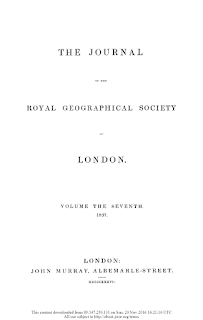The tents of Turcomans in
Azerbaijan
The
value of an I’liyat1 tent is about six to seven tumans. It is made
of goats’ hair, consisting of cloths about a foot and a quarter in width, wove
by the women. All the members of a family, men, women, and children, are
usually employed spinning goats’ hair, which is either in actual use in the
loom, or laid by for sale. They weave the cloth in a portable loom, which they
fix in the rudest manner possible, but which answers all the purposes for which
it is intended. This cloth is of strong texture, impervious to rain, and will
last twenty years. The covering of one of the tents is generally about forty
feet in length, and twenty in breadth, and is erected upon a range of poles,
the back and sides being fitted up with reeds made into walls, and is fastened
to the ground with pegs. The tents are extremely rude, and do not show any
appearance of attention to comfort. In Azerbaijan and the more northern, and
consequently rainy countries, they have another sort of tent, which has been
borrowed from the Turkomans. This consists of ribs united, and, when pen, is
like a cage, on which thick felts are thrown, and it is entered by a narrow
door. It is called alajeh2; the goats’ hair tents are called ḳarah chader, or black tent.
1I’liyat and I’lat (Memoirs of Abu-l Kerim, by Gladwin,
p. 29) are the Arabic plurals of I’liyah or I’lah, singulars formed from the
Turkish word I’l, or its derivative I’li. I’l, and consequently I’lah, signifies
a family or tribe, and is synonymous with the Arabic word ‘ashirah, used for
“tribe” by the Kurds. Hence, it may be remarked, the names of several Turkish
provinces, I’ch-il, Hamid-ili, Khojah-ili, Rum-ili, &c., mean the country
inhabited by “the Interior Family,” or tribe of Hamid, Khojah, the Romans,
&c. The first writer who speaks of the I’liyat, under the name of Elli, is
the learned Jesuit, Villotte (Voyages d’un Missionaire, Paris, 1730, p. 112).
Accounts of them are also given by M. Rousseau (Notice Historique de la Perse),
Sir J. Malcolm (History of Persia, vol. i p. 502), Sir W. Ouseley (Travels,
vol. i. p. 307), M. Jaubert (Voyages, 240, 241, 250-256), Malte-Brun (Precis de
la Géographie, vol. iii. P.
280), and M. Dupré (Voyage en Perse, Paris, 1819, vol. ii. p. 452).
2Or alajak, «a portable hut,» ― a Chghatai term.
James Morier — Some Account of the I'liyats, or
Wandering Tribes of Persia, obtained in the Years 1814 and 1815 (1837)

Comments
Post a Comment